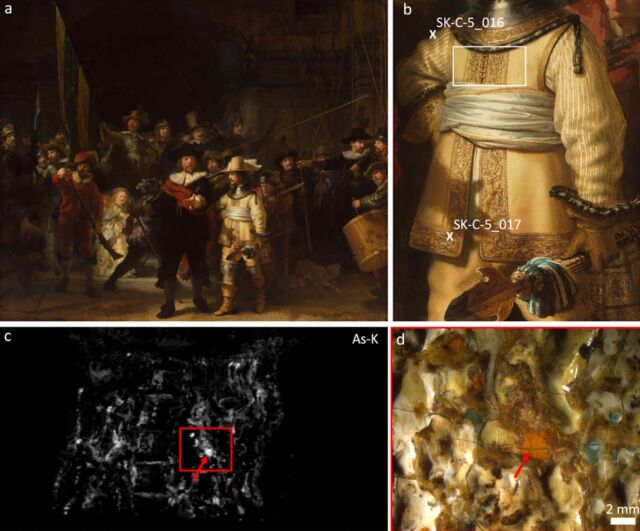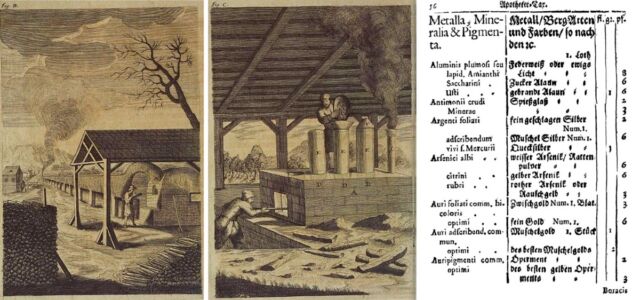Scientists unlock more secrets of Rembrandt’s pigments in The Night Watch

Public domain
Since 2019, researchers have been analyzing the chemical composition of the materials used to create Rembrandt’s masterpiece, The Night Watch, as part of the Rijksmuseum’s ongoing Operation Night Watch, devoted to its long-term preservation. Chemists at the Rijksmuseum and the University of Amsterdam have now detected unusual arsenic-based yellow and orange/red pigments used to paint the duff coat of one of the central figures in the painting, according to a recent paper in the journal Heritage Science. It’s a new addition to Rembrandt’s known pigment palette that further adds to our growing body of knowledge about the materials he used.
As previously reported, past analyses of Rembrandt’s paintings identified many pigments the Dutch master used in his work, including lead white, multiple ochres, bone black, vermilion, madder lake, azurite, ultramarine, yellow lake, and lead-tin yellow, among others. The artist rarely used pure blue or green pigments, with Belshazzar’s Feast being a notable exception. (The Rembrandt Database is the best resource for a comprehensive chronicling of the many different investigative reports.)
Early last year, the researchers at Operation Night Watch found rare traces of a compound called lead formate in the painting—surprising in itself, but the team also identified those formates in areas where there was no lead pigment, white or yellow. It’s possible that lead formates disappear fairly quickly, which could explain why they have not been detected in paintings by the Dutch Masters until now. But if that is the case, why didn’t the lead formate disappear in The Night Watch? And where did it come from in the first place?
Hoping to answer these questions, the team whipped up a model of “cooked oils” from a 17th-century recipe and analyzed those model oils with synchrotron radiation. The results supported their hypothesis that the oil used for light parts of the painting was treated with an alkaline lead drier. The fact that The Night Watch was revarnished with an oil-based varnish in the 18th century complicates matters, as this may have provided a fresh source of formic acid, such that different regions of the painting rich in lead formates may have formed at different times in the painting’s history.
Last December, the team turned their attention to the preparatory layers applied to the canvas. It’s known that Rembrandt used a quartz-clay ground for The Night Watch—the first time he had done so, perhaps because the colossal size of the painting “motivated him to look for a cheaper, less heavy and more flexible alternative for the ground layer” than the red earth, lead white, and cerussite he was known to use on earlier paintings.

N. De Keyser et al., 2024
They used 3D X-ray methods to capture more detail, revealing the presence of an unknown (and unexpected) lead-containing layer located just underneath the ground layer. This could be due to using a lead compound added to the oil used to prepare the canvas as a drying additive—perhaps to protect the painting from the damaging effects of humidity. (Usually a glue sizing was used before applying the ground layer.) The lead layer discovered last year could be the reason for the unusual lead protrusions in areas of The Night Watch, since there are no other lead-containing compounds in the paint. It’s possible that lead migrated into the painting’s ground layer from the lead-oil preparatory layer below.
An intentional combination
The presence of arsenic sulfides in The Night Watch appears to be an intentional pigment combination by Rembrandt, according to the authors of this latest paper. Artists throughout history have used naturally occurring orpiment and realgar, as well as artificial arsenic sulfide pigments, to get yellow, orange, and red hues in their paints. Orpiment was also used for medicinal purposes, in hair removal creams and oils, in wax seals, yellow ink, bookbinder green (mixed with indigo), and for the treatment or coating of metals like silver.
But the use of artificial arsenic sulfides have rarely been reported in artworks, although they are mentioned in multiple artists’ treatises dating back to the 15th century. Earlier work using advanced analytical techniques such as Raman spectroscopy and X-ray powder diffraction revealed that Rembrandt used arsenic sulfide pigments (artificial orpiment) in two late paintings: The Jewish Bride (c 1665) and The Man in a Red Cap (c 1665).
For this latest work, Nouchka De Keyser of the Rijksmuseum and co-authors used macroscopic X-ray fluorescence imaging to map The Night Watch, which revealed the presence of arsenic and sulfur in the doublet sleeves and embroidered buff coat worn by Lt. Willem Van Ruytenburch, i.e., the central figure to the right of Captain Frans Bannick Cocq in the painting. The researchers initially assumed that this was due to Rembrandt’s use of orpiment for yellow hues and realgar for red hues.

N. De Keyser et al., 2024
To learn more, they took tiny samples and analyzed them with light microscopy, micro-Raman spectroscopy, electron microscopy, and X-ray powder diffraction. They found the yellow particles were actually pararealgar while the orange to red particles were semi-amorphous pararealgar. These are more unusual arsenic sulfide components, typically associated with degradation products from either the natural minerals or their artificial equivalents as they age.
But De Keyser et al. concluded that the presence of these components was actually an intentional mixture, based on their perusal of multiple historical sources and catalogs of collection cabinets with long lists of various arsenic sulfides. There was clearly contemporary knowledge of manipulating both natural and artificial arsenic sulfides to get different shades of yellow, orange, and red.
They also found vermilion and lead-tin yellow in the paint mixture; Rembrandt was known to use these to add brightness and intensity to his paintings. In the case of The Night Watch, “Rembrandt clearly aimed for a bright orange tone with a high color strength that allowed him to create an illusion of the gold thread embroidery in Van Ruytenburch’s costume,” the authors wrote. “The artificial orange to red arsenic sulfide might have offered different optical and rheological paint properties as compared to the mineral form of orpiment and realgar.”
In addition, the team examined paint samples from different artists known to use arsenic sulfides—whose works are also part of the Rijksmuseum collection—and found a similar mixture of pigments in a painting by Rembrandt’s contemporary, Willem Kalf. “It is evidence that a variety of natural and artificial arsenic sulfides were manufactured and traded during Rembrandt’s time and were available in Amsterdam,” the authors wrote—most likely imported, since the Dutch Republic did not have considerable mining resources.
DOI: Heritage Science, 2024. 10.1186/s40494-024-01350-x (About DOIs).
Source link


